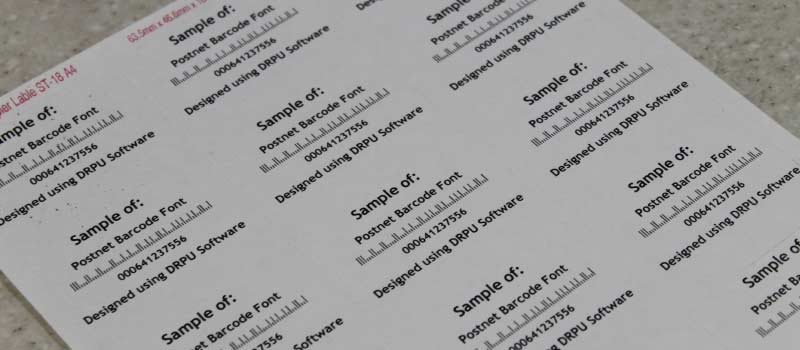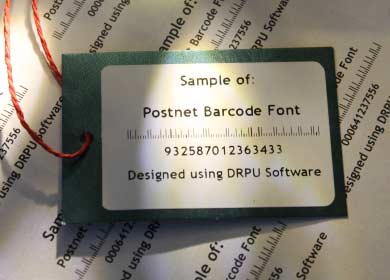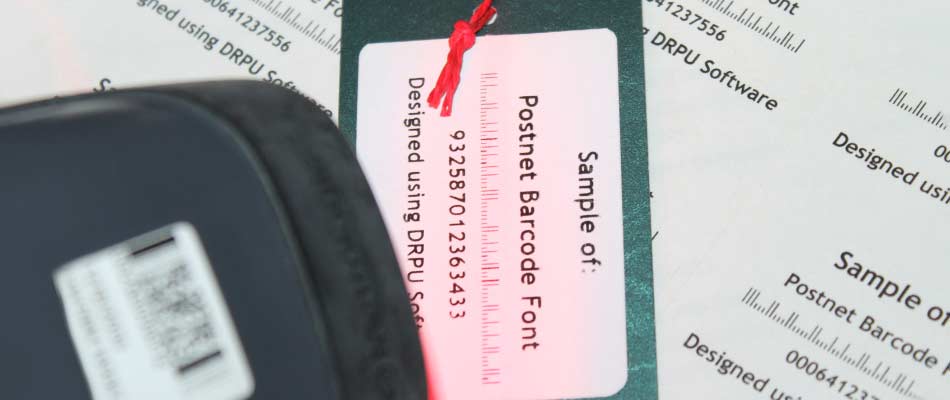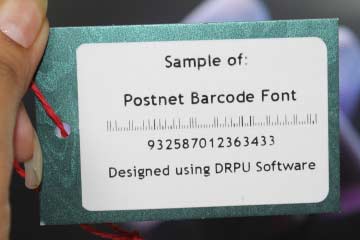Postnet Barcode Different From Other Barcode Types
Postnet barcode uses a unique encoding scheme that is optimized for mail processing, making it highly reliable and accurate in sorting and delivering mail to the correct address.
One of the key differences between Postnet barcode and other barcode types is the way in which it encodes data. Postnet barcode uses a binary code that represents each digit in a zip code or delivery point code as a series of five bars and spaces, with each bar and space having two possible states: tall or short. In contrast, other barcode types such as UPC and Code 128 use a combination of bars and spaces of varying widths to represent data.
Another difference is the way in which Postnet barcode is used. While other barcode types are used primarily for product labeling and inventory management, Postnet barcode is used exclusively by USPS for mail sorting and delivery. This means that it is not commonly used outside of USPS operations and is not as widely recognized by other industries.
Postnet barcode is also unique in its limitations. It can only encode numeric data and is restricted to encoding zip codes, zip+4 codes, and delivery point codes. This makes it unsuitable for encoding other types of data such as product information, prices, and descriptions.
Despite these differences, Postnet barcode shares many similarities with other barcode types. For example, both Postnet barcode and other barcode types use machine-readable patterns of bars and spaces to encode data, and both require a barcode scanner or reader to decode the information.
Overall, the unique encoding scheme, specialized use, and limitations of Postnet barcode set it apart from other barcode types, while its similarities in barcode structure and decoding process make it a familiar technology for those who work with barcodes.
Characters can be Encoded Postnet Barcode System
A Postnet barcode is a type of barcode that is used to encode ZIP codes for efficient mail sorting and delivery by the United States Postal Service (USPS). It is a 5-digit code that represents a unique location within the United States. The Postnet barcode was first introduced in 1982 as a way to improve the efficiency and accuracy of mail delivery. The barcode uses a series of vertical bars to represent the digits of the ZIP code, with each bar representing either a full or half bar. The structure of a Postnet barcode is designed to allow for easy reading and decoding by machines, making it a reliable and effective way to sort and deliver mail.

Download and Install
Barcode Label Maker SoftwareThe characters that can be encoded in a Postnet barcode are limited to the 5-digit ZIP code used by the USPS. Each digit of the ZIP code is represented by a set of bars in the barcode, with each set of bars consisting of either 5 or 6 bars. The first and last digits are represented by half bars, while the middle digits are represented by full bars. The length of the barcode is determined by the number of digits in the ZIP code, with a 5-digit code resulting in a barcode that is 32 bars long, and a 9-digit code resulting in a barcode that is 62 bars long.
In addition to the 5-digit ZIP code, the Postnet barcode can also encode a ZIP+4 code, which includes an additional 4 digits that provide more specific location information. The ZIP+4 code is represented by a 9-digit number, with the first 5 digits encoded in the same way as a 5-digit ZIP code, and the last 4 digits represented by additional bars. The use of the ZIP+4 code can further improve the efficiency and accuracy of mail delivery by providing more detailed location information to USPS sorting machines.
Uses Of Printing Postnet Barcodes System

Printing Postnet barcodes is a relatively straightforward process that requires the use of a high-quality printer and software or online tool to generate the barcode. With proper formatting and printing techniques, Postnet barcodes can be accurate, durable, and easily readable by scanners.Postnet barcode is a powerful tool for improving the efficiency of postal services in the United States, reducing costs and improving the speed and accuracy of mail delivery.
There are a wide range of devices that can read Postnet barcodes, making it a versatile and widely-used barcode format in a variety of industries. The Postnet barcode also includes a check digit. The check digit is calculated based on the other digits in the ZIP code or postal information being encoded, and it is used to verify that the barcode has been read correctly.
Scan Postnet Barcodes System
Scanning a Postnet barcode is a simple process that involves using a barcode scanner or reader to capture the barcode data and decode it into readable information. Here are the steps involved in scanning a Postnet barcode:
Position the barcode scanner in such a way that the barcode is within its field of view. Most barcode scanners have a red laser that is used to read the barcode. Position the laser beam in the center of the barcode and ensure that the laser is not blocked by any object.
Activate the barcode scanner by pressing the trigger button or by swiping the scanner over the barcode. The scanner will emit a red laser that will scan the barcode.
The barcode scanner will capture the barcode data by analyzing the pattern of the black and white lines that make up the barcode. The scanner will then decode the barcode data into readable information.
After decoding the barcode data, it is important to validate it to ensure that it is accurate and error-free. This can be done by comparing the decoded data with the information on the product or document that the barcode is attached to.
The decoded barcode data can be used for a variety of purposes, such as inventory tracking, product identification, and asset management.
Postnet Barcode Read and Decode System
-
Postnet barcode is a type of barcode that is used primarily for postal services in the United States. It is a type of barcode that encodes zip codes and other delivery information. In order to read and decode Postnet barcodes, a special type of scanner is used that is capable of reading the specific format of the barcode. In this article, we will discuss the process of reading and decoding Postnet barcodes.
-
Postnet barcodes are read and decoded using specialized barcode scanners that are designed to read the specific format of the barcode. These scanners use a light source and a sensor to capture the pattern of bars and spaces in the barcode. The pattern of bars and spaces in the barcode is then decoded into a series of numbers and letters that represent the information encoded in the Postnet barcode.
-
The process of reading and decoding Postnet barcodes involves several steps. The first step is to ensure that the barcode is properly aligned with the scanner. This can be done by placing the barcode in the center of the scanner's field of view and ensuring that it is not tilted or at an angle. Once the barcode is properly aligned, the scanner will emit a light to source that illuminates to the Postnet barcode.
As the scanner moves over the barcode, it detects the pattern of bars and spaces in the barcode. The pattern of bars and spaces is then decoded into a series of numbers and letters that represent the information encoded in the barcode. The scanner then sends this information to a computer or other device that is capable of interpreting the data.

In order to ensure that the barcode is properly read and decoded, it is important that the barcode is printed clearly and accurately. Any smudging, fading, or other defects in the barcode can interfere with the scanning process and make it difficult or impossible to read and decode the barcode. It is also important to ensure that the barcode is printed at the correct size and resolution.
Download and Install
Barcode Label Maker SoftwareMinimum and Maximum Length Of Postnet Barcode
The Postnet barcode has a fixed length of 32 bars, with each bar being either short or tall. However, the number of digits that can be encoded in a Postnet barcode varies based on the format used. There are three formats of Postnet barcode, each with different minimum and maximum lengths:
-
015-digit ZIP
Code format:
This format is used to encode 5-digit ZIP codes and has a fixed length of 22 bars. The minimum number of digits that can be encoded in this format is 5, and the maximum is 5.
-
029-digit
ZIP+4 format:
This format is used to encode 9-digit ZIP codes and has a fixed length of 32 bars. The minimum number of digits that can be encoded in this format is 9, and the maximum is 9.
-
03Delivery
Point format:
This format is used to encode the Delivery Point Barcode (DPBC) and has a fixed length of 62 bars. The DPBC is used to encode the exact location of a delivery point within a ZIP+4 code, and consists of a 2-digit carrier route code, a 3-digit delivery point code, and a check digit. The minimum number of digits that can be encoded in this format is 11 (2 digits for the carrier route code, 3 digits for the delivery point code, and 6 digits for the ZIP+4 code), and the maximum is 11.
It's worth noting that while the length of the Postnet barcode is fixed, the actual size of the barcode can vary depending on the printing resolution and the width of the bars. A larger barcode may be easier for a scanner to read, but may not fit on certain types of mailpieces.
Conclusion
In addition to specialized barcode scanners, Postnet barcodes can also be read and decoded using mobile devices such as smartphones and tablets. There are a number of barcode scanning apps available for mobile devices that are capable of reading Postnet barcodes. These apps use the camera on the mobile device to capture an image of the barcode and then decode the pattern of bars and spaces in the barcode into a series of numbers and letters. Overall, the process of reading and decoding Postnet barcodes is a relatively simple and straightforward process that can be accomplished using specialized barcode scanners or mobile devices. The accuracy and reliability of the scanning process depend on a number of factors, including the quality of the barcode and the alignment of the barcode with the scanner. However, when properly aligned and printed, Postnet barcodes can be a highly effective and efficient way to encode and transmit postal and delivery information.
 DOWNLOAD
DOWNLOAD DOWNLOAD
DOWNLOAD